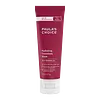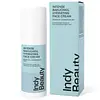What's inside
What's inside
 Key Ingredients
Key Ingredients

 Benefits
Benefits

 Concerns
Concerns

 Ingredients Side-by-side
Ingredients Side-by-side

Water
Skin ConditioningPropylene Glycol Dicaprylate/Dicaprate
EmollientButylene Glycol
HumectantGlycerin
HumectantSorbitan Stearate
EmulsifyingCaprylic/Capric Triglyceride
MaskingCetearyl Alcohol
EmollientGlyceryl Stearate
EmollientDicaprylyl Carbonate
EmollientEthyl Macadamiate
Skin ConditioningCyclopentasiloxane
EmollientCyclohexasiloxane
EmollientGlyceryl Behenate/Eicosadioate
EmollientBorago Officinalis Seed Oil
EmollientOenothera Biennis Oil
EmollientOlea Europaea Fruit Oil
MaskingPrunus Armeniaca Fruit
AstringentGlycine Soja Sterols
EmollientTocopheryl Acetate
AntioxidantTocopherol
AntioxidantTetrahexyldecyl Ascorbate
AntioxidantAscorbyl Palmitate
AntioxidantLinoleic Acid
CleansingPhospholipids
Skin ConditioningSodium Hyaluronate
HumectantRetinyl Palmitate
Skin ConditioningSodium Dilauramidoglutamide Lysine
HumectantCetearyl Glucoside
EmulsifyingSclerotium Gum
Emulsion StabilisingHectorite
AbsorbentCaprylyl Glycol
EmollientEthylhexylglycerin
Skin ConditioningPhenoxyethanol
PreservativeWater, Propylene Glycol Dicaprylate/Dicaprate, Butylene Glycol, Glycerin, Sorbitan Stearate, Caprylic/Capric Triglyceride, Cetearyl Alcohol, Glyceryl Stearate, Dicaprylyl Carbonate, Ethyl Macadamiate, Cyclopentasiloxane, Cyclohexasiloxane, Glyceryl Behenate/Eicosadioate, Borago Officinalis Seed Oil, Oenothera Biennis Oil, Olea Europaea Fruit Oil, Prunus Armeniaca Fruit, Glycine Soja Sterols, Tocopheryl Acetate, Tocopherol, Tetrahexyldecyl Ascorbate, Ascorbyl Palmitate, Linoleic Acid, Phospholipids, Sodium Hyaluronate, Retinyl Palmitate, Sodium Dilauramidoglutamide Lysine, Cetearyl Glucoside, Sclerotium Gum, Hectorite, Caprylyl Glycol, Ethylhexylglycerin, Phenoxyethanol
Water
Skin ConditioningGlycerin
HumectantGlyceryl Stearate
EmollientButyrospermum Parkii Butter
Skin ConditioningNiacinamide
SmoothingShea Butter Ethyl Esters
EmollientOlive Oil Decyl Esters
Cetearyl Alcohol
EmollientCetyl Alcohol
EmollientPolyglyceryl-6 Palmitate/Succinate
EmulsifyingSqualane
EmollientTocopheryl Acetate
AntioxidantHydrogenated Coco-Glycerides
EmollientSodium Hyaluronate
HumectantBakuchiol
AntimicrobialUbiquinone
AntioxidantJojoba Esters
EmollientN-Prolyl Palmitoyl Tripeptide-56 Acetate
Skin ConditioningSphingolipids
EmollientPhospholipids
Skin ConditioningSorbitan Isostearate
EmulsifyingHydroxyethyl Acrylate/Sodium Acryloyldimethyl Taurate Copolymer
Emulsion StabilisingSqualene
EmollientXanthan Gum
EmulsifyingPentylene Glycol
Skin ConditioningTocopherol
AntioxidantGlycine Soja Oil
EmollientBeta-Sitosterol
Emulsion StabilisingPhenoxyethanol
PreservativeEthylhexylglycerin
Skin ConditioningPolysorbate 60
EmulsifyingCaprylyl Glycol
EmollientWater, Glycerin, Glyceryl Stearate, Butyrospermum Parkii Butter, Niacinamide, Shea Butter Ethyl Esters, Olive Oil Decyl Esters, Cetearyl Alcohol, Cetyl Alcohol, Polyglyceryl-6 Palmitate/Succinate, Squalane, Tocopheryl Acetate, Hydrogenated Coco-Glycerides, Sodium Hyaluronate, Bakuchiol, Ubiquinone, Jojoba Esters, N-Prolyl Palmitoyl Tripeptide-56 Acetate, Sphingolipids, Phospholipids, Sorbitan Isostearate, Hydroxyethyl Acrylate/Sodium Acryloyldimethyl Taurate Copolymer, Squalene, Xanthan Gum, Pentylene Glycol, Tocopherol, Glycine Soja Oil, Beta-Sitosterol, Phenoxyethanol, Ethylhexylglycerin, Polysorbate 60, Caprylyl Glycol
 Reviews
Reviews

Ingredients Explained
These ingredients are found in both products.
Ingredients higher up in an ingredient list are typically present in a larger amount.
Caprylyl Glycol is a humectant and emollient, meaning it attracts and preserves moisture.
It is a common ingredient in many products, especially those designed to hydrate skin. The primary benefits are retaining moisture, skin softening, and promoting a healthy skin barrier.
Though Caprylyl Glycol is an alcohol derived from fatty acids, it is not the kind that can dry out skin.
This ingredient is also used as a preservative to extend the life of products. It has slight antimicrobial properties.
Learn more about Caprylyl GlycolCetearyl alcohol is a mixture of two fatty alcohols: cetyl alcohol and stearyl alcohol. It is mainly used as an emulsifier. Emulsifiers help prevent the separation of oils and products. Due to its composition, it can also be used to thicken a product or help create foam.
Cetearyl alcohol is an emollient. Emollients help soothe and hydrate the skin by trapping moisture.
Studies show Cetearyl alcohol is non-toxic and non-irritating. The FDA allows products labeled "alcohol-free" to have fatty alcohols.
This ingredient is usually derived from plant oils such as palm, vegetable, or coconut oils. There is debate on whether this ingredient will cause acne.
Due to the fatty acid base, this ingredient may not be Malassezia folliculitis safe.
Learn more about Cetearyl AlcoholEthylhexylglycerin (we can't pronounce this either) is commonly used as a preservative and skin softener. It is derived from glyceryl.
You might see Ethylhexylglycerin often paired with other preservatives such as phenoxyethanol. Ethylhexylglycerin has been found to increase the effectiveness of these other preservatives.
Glycerin is already naturally found in your skin. It helps moisturize and protect your skin.
A study from 2016 found glycerin to be more effective as a humectant than AHAs and hyaluronic acid.
As a humectant, it helps the skin stay hydrated by pulling moisture to your skin. The low molecular weight of glycerin allows it to pull moisture into the deeper layers of your skin.
Hydrated skin improves your skin barrier; Your skin barrier helps protect against irritants and bacteria.
Glycerin has also been found to have antimicrobial and antiviral properties. Due to these properties, glycerin is often used in wound and burn treatments.
In cosmetics, glycerin is usually derived from plants such as soybean or palm. However, it can also be sourced from animals, such as tallow or animal fat.
This ingredient is organic, colorless, odorless, and non-toxic.
Glycerin is the name for this ingredient in American English. British English uses Glycerol/Glycerine.
Learn more about GlycerinGlyceryl Stearate is a mix of glycerin and stearic acid.
It is used to stabilize the mixing of water and oil ingredients. By preventing these ingredients from separating, it can help elongate shelf life. It can also help thicken the product's texture.
As an emollient, it helps soften skin and supports barrier-replenishing ingredients.
In cosmetics, Glyceryl Stearate is often made from vegetable oils or synthetically produced.
This ingredient may not be fungal-acne safe
Fun fact: The human body also creates Glyceryl Stearate naturally.
Learn more about Glyceryl StearatePhenoxyethanol is a preservative that has germicide, antimicrobial, and aromatic properties. Studies show that phenoxyethanol can prevent microbial growth. By itself, it has a scent that is similar to that of a rose.
It's often used in formulations along with Caprylyl Glycol to preserve the shelf life of products.
Phospholipids are naturally found in our skin as they are the main component of cell membranes. Phospholipids have humectant, emollient, antioxidant properties.
Phospholipids are complex lipids that contain glycerin, two fatty acids, and a phosphate group. Some foods that contain phospholipids include soybeans and milk. The phospholipids found in soy come from Lecithin. This ingredient can also be synthetically created.
Due to their hygroscopic nature, they act as both humectants and emollients. Humectants draw moisture from the air to your skin, while emollients help trap moisture in.
The phospholipids in our skin can be naturally depleted. Replenishing the phospholipids in our skin can help hydrate your skin.
Studies show phospholipids display antioxidant activity and may help with reducing the signs of aging.
This ingredient is non-occlusive.
Some types of phospholipids:
Learn more about PhospholipidsSodium Hyaluronate is hyaluronic acid's salt form. It is commonly derived from the sodium salt of hyaluronic acid.
Like hyaluronic acid, it is great at holding water and acts as a humectant. This makes it a great skin hydrating ingredient.
Sodium Hyaluronate is naturally occurring in our bodies and is mostly found in eye fluid and joints.
These are some other common types of Hyaluronic Acid:
Learn more about Sodium HyaluronateTocopherol (also known as Vitamin E) is a common antioxidant used to help protect the skin from free-radicals and strengthen the skin barrier. It's also fat soluble - this means our skin is great at absorbing it.
Vitamin E also helps keep your natural skin lipids healthy. Your lipid skin barrier naturally consists of lipids, ceramides, and fatty acids. Vitamin E offers extra protection for your skin’s lipid barrier, keeping your skin healthy and nourished.
Another benefit is a bit of UV protection. Vitamin E helps reduce the damage caused by UVB rays. (It should not replace your sunscreen). Combining it with Vitamin C can decrease sunburned cells and hyperpigmentation after UV exposure.
You might have noticed Vitamin E + C often paired together. This is because it is great at stabilizing Vitamin C. Using the two together helps increase the effectiveness of both ingredients.
There are often claims that Vitamin E can reduce/prevent scarring, but these claims haven't been confirmed by scientific research.
Learn more about TocopherolTocopheryl Acetate is AKA Vitamin E. It is an antioxidant and protects your skin from free radicals. Free radicals damage the skin by breaking down collagen.
One study found using Tocopheryl Acetate with Vitamin C decreased the number of sunburned cells.
Tocopheryl Acetate is commonly found in both skincare and dietary supplements.
Learn more about Tocopheryl AcetateWater. It's the most common cosmetic ingredient of all. You'll usually see it at the top of ingredient lists, meaning that it makes up the largest part of the product.
So why is it so popular? Water most often acts as a solvent - this means that it helps dissolve other ingredients into the formulation.
You'll also recognize water as that liquid we all need to stay alive. If you see this, drink a glass of water. Stay hydrated!
Learn more about Water